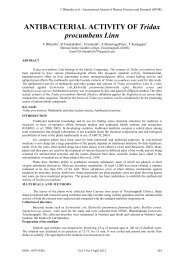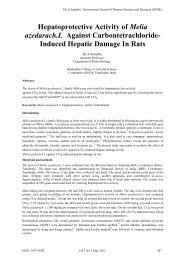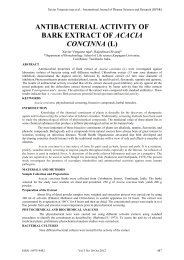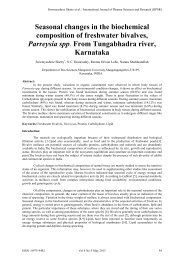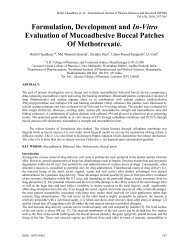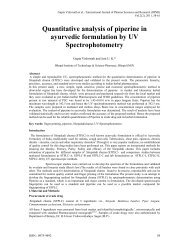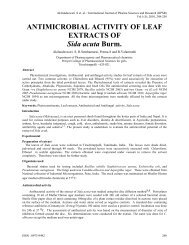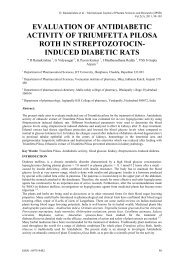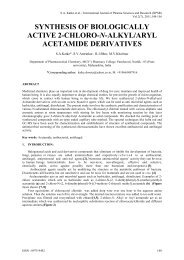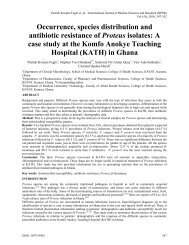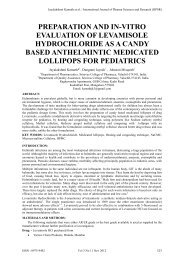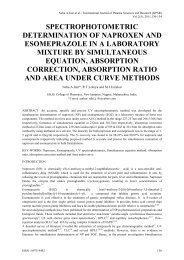Immunomodulatory Activity of Abutilon Indicum linn on Albino Mice
Immunomodulatory Activity of Abutilon Indicum linn on Albino Mice
Immunomodulatory Activity of Abutilon Indicum linn on Albino Mice
You also want an ePaper? Increase the reach of your titles
YUMPU automatically turns print PDFs into web optimized ePapers that Google loves.
N.L. DASHPUTRE et. al. / Internati<strong>on</strong>al Journal <str<strong>on</strong>g>of</str<strong>on</strong>g> Pharma Sciences and Research (IJPSR)<br />
Vol.1(3), 2010, 178-184<br />
<str<strong>on</strong>g>Immunomodulatory</str<strong>on</strong>g> <str<strong>on</strong>g>Activity</str<strong>on</strong>g> <str<strong>on</strong>g>of</str<strong>on</strong>g> <str<strong>on</strong>g>Abutil<strong>on</strong></str<strong>on</strong>g> <str<strong>on</strong>g>Indicum</str<strong>on</strong>g> <str<strong>on</strong>g>linn</str<strong>on</strong>g> <strong>on</strong> <strong>Albino</strong> <strong>Mice</strong><br />
N. L. DASHPUTRE * , N. S. NAIKWADE<br />
Department <str<strong>on</strong>g>of</str<strong>on</strong>g> Pharmacology, Appasaheb Birnale College <str<strong>on</strong>g>of</str<strong>on</strong>g> Pharmacy, South Shivaji Nagar, Sangli-416416,<br />
Maharashtra, India.<br />
ABSTRACT<br />
Purpose: To study the immunomodulatory activity <str<strong>on</strong>g>of</str<strong>on</strong>g> aqueous and ethanol extracts <str<strong>on</strong>g>of</str<strong>on</strong>g> leaves <str<strong>on</strong>g>of</str<strong>on</strong>g> <str<strong>on</strong>g>Abutil<strong>on</strong></str<strong>on</strong>g><br />
indicum Linn. (Family: Malvaceae) <strong>on</strong> albino mice.<br />
Methods: The ethanolic and aqueous extract <str<strong>on</strong>g>of</str<strong>on</strong>g> leaves <str<strong>on</strong>g>of</str<strong>on</strong>g> <str<strong>on</strong>g>Abutil<strong>on</strong></str<strong>on</strong>g> indicum was administered orally at the<br />
dosage levels <str<strong>on</strong>g>of</str<strong>on</strong>g> 200 mg/kg/day and 400 mg/kg/day body weight in mice. The assessment <str<strong>on</strong>g>of</str<strong>on</strong>g><br />
immunomodulatory activity <strong>on</strong> specific and n<strong>on</strong>-specific immunity were studied by heamagglutinati<strong>on</strong> antibody<br />
(HA) titer, delayed type hypersensitivity (DTH), neutrophil adhesi<strong>on</strong> test and carb<strong>on</strong> clearance test. In order to<br />
induced immunosuppresi<strong>on</strong> in mice by using cyclophosphamide (100 mg/kg/day, p.o.) and levamisole (50<br />
mg/kg/day, p.o.) used as immunostimulating agents.<br />
Results: Oral administrati<strong>on</strong> <str<strong>on</strong>g>of</str<strong>on</strong>g> A. indicum showed a significant increase in the producti<strong>on</strong> <str<strong>on</strong>g>of</str<strong>on</strong>g> circulating<br />
antibody titre in resp<strong>on</strong>se to sheep red blood cells (SRBCs). A significant (p
N.L. DASHPUTRE et. al. / Internati<strong>on</strong>al Journal <str<strong>on</strong>g>of</str<strong>on</strong>g> Pharma Sciences and Research (IJPSR)<br />
Vol.1(3), 2010, 178-184<br />
Animals<br />
Inbred col<strong>on</strong>y <str<strong>on</strong>g>of</str<strong>on</strong>g> swiss albino mice <str<strong>on</strong>g>of</str<strong>on</strong>g> weighing between 20-25 gm were housed in groups <str<strong>on</strong>g>of</str<strong>on</strong>g> 5 to 6. All mice<br />
were fed with pelleted diet (Pranav Agro Industries Ltd, Sangli, India) and tap water ad libitum. Instituti<strong>on</strong>al<br />
Animals Ethics Committee (IAEC) approved the experimental protocol and care <str<strong>on</strong>g>of</str<strong>on</strong>g> animals was taken as per<br />
guidelines <str<strong>on</strong>g>of</str<strong>on</strong>g> CPCSEA, Department <str<strong>on</strong>g>of</str<strong>on</strong>g> Animal Welfare, and Government <str<strong>on</strong>g>of</str<strong>on</strong>g> India. (843/ac/04/ CPCSEA).<br />
Drugs and chemicals<br />
All the drugs and chemicals were <str<strong>on</strong>g>of</str<strong>on</strong>g> analytical grade while the other drugs were procured from Levamisole<br />
(Khandelwal Pharmaceutical Ltd. Mumbai), Cyclophosphamide (Biochem pharmaceutical, Mumbai), Colloidal<br />
carb<strong>on</strong> (Indian ink, camel India Pvt. Ltd.).<br />
Test compound formulati<strong>on</strong>s<br />
The diluti<strong>on</strong> <str<strong>on</strong>g>of</str<strong>on</strong>g> aqueous extract <str<strong>on</strong>g>of</str<strong>on</strong>g> leaves <str<strong>on</strong>g>of</str<strong>on</strong>g> AI (AEAI) was prepared in distilled water and the aqueous<br />
suspensi<strong>on</strong> <str<strong>on</strong>g>of</str<strong>on</strong>g> ethanolic extract <str<strong>on</strong>g>of</str<strong>on</strong>g> leaves <str<strong>on</strong>g>of</str<strong>on</strong>g> AI (EEAI) was prepared in 0.5 % carboxymethylcellulose (CMC)<br />
soluti<strong>on</strong> in distilled water prior to oral administrati<strong>on</strong> to animals. It was used within 7 days and stored at 8 0 C<br />
while for further use, freshly prepared soluti<strong>on</strong> was used. The vehicle al<strong>on</strong>e served as c<strong>on</strong>trol.<br />
Acute toxicity studies<br />
Acute toxicity studies were performed according to organizati<strong>on</strong> for ec<strong>on</strong>omic cooperati<strong>on</strong> and development<br />
(OECD) guidelines, received draft guidelines 425, received from CPCSEA, Ministry <str<strong>on</strong>g>of</str<strong>on</strong>g> social justice and<br />
empowerment, Government <str<strong>on</strong>g>of</str<strong>on</strong>g> India. [10] <strong>Mice</strong> weighing between 20-25 gm in groups <str<strong>on</strong>g>of</str<strong>on</strong>g> five were used (n=5).<br />
The animals were fasted for 4 hr. with free access to water <strong>on</strong>ly. The both EEAI and AEAI extracts was<br />
administered orally in doses <str<strong>on</strong>g>of</str<strong>on</strong>g> 2000 and 5000 mg/kg to different groups <str<strong>on</strong>g>of</str<strong>on</strong>g> mice and observed over 14 days for<br />
mortality and physical/behavioral changes. The experiments were performed after the experimental protocols<br />
had been approved by the Instituti<strong>on</strong>al Animal Ethical committee.<br />
Thin layer chromatography<br />
TLC studies were carried out <strong>on</strong> the EEAI for flav<strong>on</strong>oids, using silica gel G TLC plates as the stati<strong>on</strong>ary phase<br />
and Chlor<str<strong>on</strong>g>of</str<strong>on</strong>g>orm : benzene : Ethanol : acetic acid : water (11 : 4 : 2 : 1 : 2 ) as the mobile phase. The TLC plates<br />
were spotted using the glass capillary and developed by spraying with ninhydrin reagent resulted in the<br />
formati<strong>on</strong> <str<strong>on</strong>g>of</str<strong>on</strong>g> bright yellow spot indicating the presence <str<strong>on</strong>g>of</str<strong>on</strong>g> flav<strong>on</strong>oids in this extract. [11]<br />
Experimental procedure<br />
Antigenic material: Preparati<strong>on</strong> <str<strong>on</strong>g>of</str<strong>on</strong>g> Sheep RBCs (SRBCs)<br />
Sheep blood was collected in sterile Alsevere’s soluti<strong>on</strong> in 1:1 proporti<strong>on</strong> <str<strong>on</strong>g>of</str<strong>on</strong>g> Alsevere’s soluti<strong>on</strong> (freshly<br />
prepared). Blood was kept in the refrigerator and processed, for the preparati<strong>on</strong> <str<strong>on</strong>g>of</str<strong>on</strong>g> SRBCs batch, by<br />
centrifugating at 2000 rpm for 10 minutes and washing with physiological saline 4-5 times and then suspending<br />
into buffered saline for further use. [12]<br />
Carb<strong>on</strong> ink suspensi<strong>on</strong>: Pelican AG, Germany, ink was diluted eight times with saline and used for carb<strong>on</strong><br />
clearance test in a dose <str<strong>on</strong>g>of</str<strong>on</strong>g> 10µl/gm body weight <str<strong>on</strong>g>of</str<strong>on</strong>g> mice. [13]<br />
Haemagglutinati<strong>on</strong> antibody (HA) titer [14]<br />
The mice were divided into eight groups c<strong>on</strong>sisting <str<strong>on</strong>g>of</str<strong>on</strong>g> five animals each. <strong>Mice</strong> in group I received vehicle <strong>on</strong>ly<br />
for 21 days. Group II received cyclophosphamide (Negative C<strong>on</strong>trol) 100 mg/kg, p.o. <strong>on</strong> 9 th and 16 th day as a<br />
single dose. <strong>Mice</strong> in treatment group III and IV were given AEAI (400 mg/kg/day/p.o) and EEAI (200<br />
mg/kg/day/p.o.) daily for 21 days respectively. Immunosuppresed animals in group V and VI were given AEAI<br />
(400 mg/kg/day/p.o) and EEAI (200 mg/kg/day/p.o.) plus cyclophosphamide (100 mg/kg/p.o.) <strong>on</strong> 9 th and 16 th<br />
day as a single dose respectively. Group VII received standard drug levamisole (50 mg/kg/p.o.) as an established<br />
immunostimulant agent for 21 days and group VIII received levamisole (50 mg/kg/p.o.) for 21 days plus<br />
cyclophosphamide (100 mg/kg/p.o.) <strong>on</strong> 9 th and 16 th day as a single dose.<br />
On 7 th and 14 th day <str<strong>on</strong>g>of</str<strong>on</strong>g> the study, mice from all the groups (i.e. group I to VIII) were immunized and challenged<br />
respectively, with SRBCs in normal saline (0.1ml <str<strong>on</strong>g>of</str<strong>on</strong>g> 20% SRBCs) intraperit<strong>on</strong>eally. Blood was withdrawn <strong>on</strong><br />
14 th and 21 st day from retro-orbital plexus under mild ether anaesthesia from all antigenically sensitised and<br />
challenged mice respectively. Blood was centrifuged to obtain serum, normal saline was used as a diluent and<br />
SRBCs count was adjusted to (0.1% <str<strong>on</strong>g>of</str<strong>on</strong>g> SRBCs). Each well <str<strong>on</strong>g>of</str<strong>on</strong>g> a microtitre plate was filled initially with 20 µl <str<strong>on</strong>g>of</str<strong>on</strong>g><br />
saline and 20 µl <str<strong>on</strong>g>of</str<strong>on</strong>g> serum was mixed in the first well <str<strong>on</strong>g>of</str<strong>on</strong>g> micro titre plate. Subsequently the 20 µl diluted serum<br />
was removed from first well and added to the next well to get tw<str<strong>on</strong>g>of</str<strong>on</strong>g>old diluti<strong>on</strong>s <str<strong>on</strong>g>of</str<strong>on</strong>g> the antibodies present in the<br />
serum. Further tw<str<strong>on</strong>g>of</str<strong>on</strong>g>old diluti<strong>on</strong>s <str<strong>on</strong>g>of</str<strong>on</strong>g> this diluted serum were similarly carried out till the last well <str<strong>on</strong>g>of</str<strong>on</strong>g> the sec<strong>on</strong>d<br />
row (24 th well), so that the antibody c<strong>on</strong>centrati<strong>on</strong> <str<strong>on</strong>g>of</str<strong>on</strong>g> any <str<strong>on</strong>g>of</str<strong>on</strong>g> the diluti<strong>on</strong>s is half <str<strong>on</strong>g>of</str<strong>on</strong>g> the previous diluti<strong>on</strong>. 20 µl<br />
SRBC (0.1% <str<strong>on</strong>g>of</str<strong>on</strong>g> SRBCs) were added to each <str<strong>on</strong>g>of</str<strong>on</strong>g> these diluti<strong>on</strong>s and the plates were incubated at 37°C for <strong>on</strong>e<br />
hour and then observed for haemagglutinati<strong>on</strong>. The highest diluti<strong>on</strong> giving haemagglutinati<strong>on</strong> was taken as the<br />
antibody titre. The antibody titres were expressed in the graded manner, the minimum diluti<strong>on</strong> (1/2) being<br />
ranked as 1, and mean ranks <str<strong>on</strong>g>of</str<strong>on</strong>g> different groups were compared for statistical significance. Antibody titre<br />
obtained <strong>on</strong> 14 th day after immunizati<strong>on</strong> (<strong>on</strong> 7 th day) and <strong>on</strong> 21 st day after challenge (<strong>on</strong> 14 th day) with SRBCs<br />
was c<strong>on</strong>sidered as primary and sec<strong>on</strong>dary humoral immune resp<strong>on</strong>se respectively.<br />
ISSN : 0975-9492 179
N.L. DASHPUTRE et. al. / Internati<strong>on</strong>al Journal <str<strong>on</strong>g>of</str<strong>on</strong>g> Pharma Sciences and Research (IJPSR)<br />
Vol.1(3), 2010, 178-184<br />
Delayed type hypersensitivity (DTH) resp<strong>on</strong>se [15-16]<br />
The drug treatment was exactly the same as described above for HA titer. On 14 th day <str<strong>on</strong>g>of</str<strong>on</strong>g> the study, all the<br />
groups I to VIII were immunized with SRBCs (0.1ml <str<strong>on</strong>g>of</str<strong>on</strong>g> 20% SRBC i.p.) in normal saline. On day 21 st all<br />
animals from all the groups were challenged with 0.03 ml <str<strong>on</strong>g>of</str<strong>on</strong>g> 20% SRBCs in subplantar regi<strong>on</strong> <str<strong>on</strong>g>of</str<strong>on</strong>g> right hind paw.<br />
Foot pad oedema in mice was used for detecti<strong>on</strong> <str<strong>on</strong>g>of</str<strong>on</strong>g> cellular immune resp<strong>on</strong>se. On 21 st day, injecti<strong>on</strong> <str<strong>on</strong>g>of</str<strong>on</strong>g> 0.1ml <str<strong>on</strong>g>of</str<strong>on</strong>g><br />
20% SRBCs in the subplantar regi<strong>on</strong> <str<strong>on</strong>g>of</str<strong>on</strong>g> right hind paw in the volume <str<strong>on</strong>g>of</str<strong>on</strong>g> 0.03 ml and normal saline in left hind<br />
paw in same volume. Foot pad reacti<strong>on</strong> was assessed after 24 hr. <strong>on</strong> 22 nd day, in terms <str<strong>on</strong>g>of</str<strong>on</strong>g> increase in the<br />
thickness <str<strong>on</strong>g>of</str<strong>on</strong>g> footpad as a result <str<strong>on</strong>g>of</str<strong>on</strong>g> hypersensitivity reacti<strong>on</strong> due to oedema, the thickness <str<strong>on</strong>g>of</str<strong>on</strong>g> the right hind<br />
footpad was measured using vernier calliper. The footpad reacti<strong>on</strong> was expressed as the difference in the<br />
thickness (m.m.) between the right foot pad injected with SRBC and the left footpad injected with normal saline.<br />
Neutrophil adhesi<strong>on</strong> test [17]<br />
<strong>Mice</strong> were divided into four groups <str<strong>on</strong>g>of</str<strong>on</strong>g> five animals each. The c<strong>on</strong>trol group I received vehicle, while animals <str<strong>on</strong>g>of</str<strong>on</strong>g><br />
treatment group II and III were given AEAI (400 mg/kg/day/p.o.) and EEAI (200 mg/kg/day/p.o.) daily for 14<br />
days respectively. Group IV received levamisole (50 mg/kg/p.o.) for 14 days. On the 14 th day <str<strong>on</strong>g>of</str<strong>on</strong>g> the treatment,<br />
blood samples from all the groups were collected by puncturing retro-orbital plexus under mild ether<br />
anaesthesia. Blood was collected in vials pre-treated by disodium EDTA and analysed for total leukocyte count<br />
(TLC) and differential leukocyte count (DLC) by fixing blood smears and staining with Leishman’s stain. After<br />
initial counts, blood samples were incubated with nyl<strong>on</strong> fiber (80 mg/ml <str<strong>on</strong>g>of</str<strong>on</strong>g> blood sample) for 15 min at 37 0 C.<br />
The incubated blood samples were again analyzed for TLC and DLC. The product <str<strong>on</strong>g>of</str<strong>on</strong>g> TLC and % neutrophil<br />
gives neutrophil index (NI) <str<strong>on</strong>g>of</str<strong>on</strong>g> blood sample. Percent neutrophil adhesi<strong>on</strong> was calculated as follows,<br />
Neutrophil adhesi<strong>on</strong>=<br />
NIU- NITx 100<br />
NI<br />
Where,<br />
NI U : Neutrophil Index before incubati<strong>on</strong> with nyl<strong>on</strong> fiber.<br />
NI T : Neutrophil Index after incubati<strong>on</strong> with nyl<strong>on</strong> fiber.<br />
U<br />
Carb<strong>on</strong> clearance test [18]<br />
The drug treatment was exactly the same as with the neutrophil adhesi<strong>on</strong> test as described above. On 14 th day, 3<br />
hours after the last dose all the animals <str<strong>on</strong>g>of</str<strong>on</strong>g> each group were given colloidal carb<strong>on</strong> intravenously in a volume <str<strong>on</strong>g>of</str<strong>on</strong>g><br />
1 ml/100 g. Blood samples were then withdrawn (25 µl) from retro-orbital plexus at 0 and 15 minutes after<br />
injecti<strong>on</strong> <str<strong>on</strong>g>of</str<strong>on</strong>g> colloidal carb<strong>on</strong> ink and lysed in sodium carb<strong>on</strong>ate soluti<strong>on</strong> (3 ml). The optical density was<br />
measured spectrophotometrically at 650 nm. The phagocytic index (K) was calculated using the formula:<br />
K = (In OD 1 – In OD 2 )<br />
(t 2 – t 1 )<br />
Where, OD 1 and OD 2 are the optical densities at time t 1 and t 2 respectively.<br />
Statistical Analysis<br />
All the results were expressed as Mean±Standard Error (SEM). Data were analyzed using <strong>on</strong>e-way Analysis <str<strong>on</strong>g>of</str<strong>on</strong>g><br />
Variance (ANOVA) followed by Tukey-Kramer multiple comparis<strong>on</strong> test. p-values
N.L. DASHPUTRE et. al. / Internati<strong>on</strong>al Journal <str<strong>on</strong>g>of</str<strong>on</strong>g> Pharma Sciences and Research (IJPSR)<br />
Vol.1(3), 2010, 178-184<br />
with the c<strong>on</strong>trol group. In immunosuppressed groups, where the immunity was suppressed by administrati<strong>on</strong> <str<strong>on</strong>g>of</str<strong>on</strong>g><br />
cyclophosphamide <strong>on</strong> day nine, EEAI (200 mg/kg/p.o.) administrati<strong>on</strong> produced a significant (P
N.L. DASHPUTRE et. al. / Internati<strong>on</strong>al Journal <str<strong>on</strong>g>of</str<strong>on</strong>g> Pharma Sciences and Research (IJPSR)<br />
Vol.1(3), 2010, 178-184<br />
Carb<strong>on</strong> Clearance Test<br />
Effect <str<strong>on</strong>g>of</str<strong>on</strong>g> AEAI and EEAI <strong>on</strong> the phagocytic activity by the carb<strong>on</strong> clearance test is shown in [Table 3]. The<br />
phagocytic activity <str<strong>on</strong>g>of</str<strong>on</strong>g> the reticulo-endothelial system is generally measured by the rate <str<strong>on</strong>g>of</str<strong>on</strong>g> removal <str<strong>on</strong>g>of</str<strong>on</strong>g> carb<strong>on</strong><br />
particles from the blood stream. In carb<strong>on</strong> clearance test, AI treated all groups, exhibited significantly high<br />
phagocytic index. The phagocytic index <str<strong>on</strong>g>of</str<strong>on</strong>g> AEAI (400 mg/kg/p.o.) and EEAI (200 mg/kg/p.o.) showed<br />
significant (p
N.L. DASHPUTRE et. al. / Internati<strong>on</strong>al Journal <str<strong>on</strong>g>of</str<strong>on</strong>g> Pharma Sciences and Research (IJPSR)<br />
Vol.1(3), 2010, 178-184<br />
c<strong>on</strong>centrati<strong>on</strong>s <str<strong>on</strong>g>of</str<strong>on</strong>g> lytic enzymes for more effective killing. When activated T H1 cells encounter certain antigens,<br />
viz. SRBCs. They secrete cytokines that induce a localised inflammatory reacti<strong>on</strong> called delayed type<br />
hypersensitivity. [23] DTH comprises <str<strong>on</strong>g>of</str<strong>on</strong>g> two phases, an initial sensitisati<strong>on</strong> phase after the primary c<strong>on</strong>tact with<br />
SRBC antigen. During this period T H1 cells are activated and cl<strong>on</strong>ally expanded by APC (antigen presenting<br />
cells) with class II MHC molecule (eg. langerhans cells and macrophages are APC involved in DTH resp<strong>on</strong>se).<br />
A subsequent exposure to the SRBCs antigen induces the effector phase <str<strong>on</strong>g>of</str<strong>on</strong>g> the DTH resp<strong>on</strong>se, where T H1 cells<br />
secrete a variety <str<strong>on</strong>g>of</str<strong>on</strong>g> cytokines that recruits and activates macrophages and other n<strong>on</strong> specific inflammatory<br />
mediators. The delay in the <strong>on</strong>set <str<strong>on</strong>g>of</str<strong>on</strong>g> the resp<strong>on</strong>se reflects the time required for the cytokines to induce the<br />
recruitment and activati<strong>on</strong> <str<strong>on</strong>g>of</str<strong>on</strong>g> macrophages. [24] Therefore, increase in DTH reacti<strong>on</strong> in mice in resp<strong>on</strong>se to T cell<br />
dependent antigen revealed the stimulatory effect <str<strong>on</strong>g>of</str<strong>on</strong>g> AEAI and EEAI <strong>on</strong> T cells.<br />
The role <str<strong>on</strong>g>of</str<strong>on</strong>g> phagocytosis is the removal <str<strong>on</strong>g>of</str<strong>on</strong>g> microorganisms and foreign bodies, dead or injured cells. The<br />
increase in the carb<strong>on</strong> clearance index reflects the enhancement <str<strong>on</strong>g>of</str<strong>on</strong>g> the phagocytic functi<strong>on</strong> <str<strong>on</strong>g>of</str<strong>on</strong>g> m<strong>on</strong><strong>on</strong>uclear<br />
macrophage and n<strong>on</strong>specific immunity. Phagocytosis by macrophages is important against the smaller parasites<br />
and its effectiveness is markedly enhanced by the ops<strong>on</strong>isati<strong>on</strong> <str<strong>on</strong>g>of</str<strong>on</strong>g> parasites with antibodies and complementing<br />
C3b, leading to a more rapid clearance <str<strong>on</strong>g>of</str<strong>on</strong>g> parasites from the blood. [25] AI appeared to enhance the phagocytic<br />
functi<strong>on</strong> by exhibiting a clearance rate <str<strong>on</strong>g>of</str<strong>on</strong>g> carb<strong>on</strong> by the cells <str<strong>on</strong>g>of</str<strong>on</strong>g> the reticulo-endothelium system.<br />
Cytokines are secreted by activated immune cells for marginati<strong>on</strong> and extravasati<strong>on</strong> <str<strong>on</strong>g>of</str<strong>on</strong>g> the phagocytes mainly<br />
polymorph<strong>on</strong>uclear neutrophils. Significantly evoked increase in the adhesi<strong>on</strong> <str<strong>on</strong>g>of</str<strong>on</strong>g> neutrophils to nyl<strong>on</strong> fibers<br />
which correlates to the process <str<strong>on</strong>g>of</str<strong>on</strong>g> marginati<strong>on</strong> <str<strong>on</strong>g>of</str<strong>on</strong>g> cells in blood vessels. [16] In the present study, AI evoked a<br />
significant increase in percent <str<strong>on</strong>g>of</str<strong>on</strong>g> neutrophils. This may help in increasing immunity <str<strong>on</strong>g>of</str<strong>on</strong>g> body against microbial<br />
infecti<strong>on</strong>s.<br />
Since AI was found to have a significant immunostimulatory activity <strong>on</strong> both the specific and n<strong>on</strong>-specific<br />
immune mechanisms. The significant increase in the immunostimulatory activity <str<strong>on</strong>g>of</str<strong>on</strong>g> AI could be attributed to the<br />
presence <str<strong>on</strong>g>of</str<strong>on</strong>g> flav<strong>on</strong>oids (quercetin), alkaloids, tannins, sap<strong>on</strong>in glycosides and phenolic compounds. Therefore,<br />
the plant holds promise for being used as an immunostimulating agent and an in-depth study <strong>on</strong> various<br />
fracti<strong>on</strong>s <str<strong>on</strong>g>of</str<strong>on</strong>g> the extract effective as immunomodulating entities from the plant is warranted to determine the<br />
most potent immunostimulating fracti<strong>on</strong> from AI. Thus, the study validates the traditi<strong>on</strong>al use <str<strong>on</strong>g>of</str<strong>on</strong>g> AI as a<br />
‘Rasayana’ in Ayurvedic system <str<strong>on</strong>g>of</str<strong>on</strong>g> medicine.<br />
CONCLUSION<br />
The results <str<strong>on</strong>g>of</str<strong>on</strong>g> the present study suggest that the aqueous and ethanolic extracts <str<strong>on</strong>g>of</str<strong>on</strong>g> A. indicum leaves may be<br />
beneficial in the treatment <str<strong>on</strong>g>of</str<strong>on</strong>g> impaired immunity. Further studies to identify the active moieties and elucidati<strong>on</strong><br />
<str<strong>on</strong>g>of</str<strong>on</strong>g> the mechanism <str<strong>on</strong>g>of</str<strong>on</strong>g> acti<strong>on</strong> are recommended.<br />
ACKNOWLEDGEMENTS<br />
The authors thank to Appasaheb Birnale College <str<strong>on</strong>g>of</str<strong>on</strong>g> Pharmacy, Sangli, Maharashtra for providing lab facilities.<br />
REFERENCES<br />
[1] H. Sagrawat, Y. Khan. <str<strong>on</strong>g>Immunomodulatory</str<strong>on</strong>g> Plants: A Phytopharmacological and Pharmacognosy Review, 2007; 1:2 : 248-60.<br />
[2] H. Wagner. Search for plant derived natural products with immunostimulatory activity (recent advances). Pure and Applied Chemistry,<br />
1990; 62:7: 1217-22.<br />
[3] The Ayurvedic Pharmacopoeia <str<strong>on</strong>g>of</str<strong>on</strong>g> India Part- I Volume-I, p.12.<br />
[4] K.R. Kirtikar, B.D. Basu. Indian Medicinal Plants. 2 nd ed.vol.2, Allahabad, I: Lalit Mohan Basu, 1961. p.314-315.<br />
[5] K.M. Nadkarni. Indian Materia Medica. In: Nadkarni KM editor. 1 st ed. Mumbai: popular prakashan. 1976. p. 8-9.<br />
[6] A.P. Deshpande, R.R. Jawlekar, S. Rande. Dravyaguna vidgnyan. Vol. I-II, Pune: Anmol prakashan; 2002. p. 367-8.<br />
[7] K.N. Gaind , K.S. Chopra, Phytochemical investigati<strong>on</strong> <str<strong>on</strong>g>of</str<strong>on</strong>g> <str<strong>on</strong>g>Abutil<strong>on</strong></str<strong>on</strong>g> indicum, Planta Med., 1976; 30:2: 174-88.<br />
[8] G.E. Trease, M.C. Evans. Textbook <str<strong>on</strong>g>of</str<strong>on</strong>g> Pharmacognosy, Balliere, Tindall, L<strong>on</strong>d<strong>on</strong>, 12 th editi<strong>on</strong>, 1983; 343-383.<br />
[9] C.K. Kokate, A.P. Purohit, S.B. Gokhale. Pharmacognosy. Immunomodulators, Adaptogens and Rasayana, Analytical<br />
pharmacognosy. Pune: Archana enterprises; 17th ed. 2001; 586- 8. ,114-7.<br />
[10] OECD Guidelines for testing <str<strong>on</strong>g>of</str<strong>on</strong>g> chemical, revised draft guidelines 425:30, Acute Oral Toxicity-Up-and-Down Procedure: 2001.<br />
[11] A.B. Gokhale, A.S. Damre, M.N. Saraf. Investigati<strong>on</strong>s into the immunomodulatory activity <str<strong>on</strong>g>of</str<strong>on</strong>g> Argyreia Speciosa. J<br />
Ethnopharmacology, 2003 ; 84 : 109-14.<br />
[12] S. Dash, L.K. Nath, S. Bhise, P. Kar, S. Bhattacharya. Stimulati<strong>on</strong> <str<strong>on</strong>g>of</str<strong>on</strong>g> immune functi<strong>on</strong> activity by the alcoholic root extract <str<strong>on</strong>g>of</str<strong>on</strong>g><br />
Heracleum nepalense D. D<strong>on</strong>. Indian J Pharmacology, 2006; 38 :5: 336-40.<br />
[13] A.A. Joharapurkar, M.M. Wanjari, S.P. Zambad, S.N. Umathe. Pyrogallol : A novel tool for screening immunomodulators. Indian J<br />
Pharmacology, 2004; 36: 355-9.<br />
[14] R. Agarwal, S. Diwanay, P. Patki, B. Patwardhan. Studies <strong>on</strong> immunomodulatory activity <str<strong>on</strong>g>of</str<strong>on</strong>g> Withania somnifera (Ashwagandha)<br />
extracts in experimental immune inflammati<strong>on</strong>. J Ethnopharmacology, 1999 ; 67 : 27–35.<br />
[15] S.V. Fulzele, P.M. Satturwar, S.B. Joshi, A.K. Dorle. Study <str<strong>on</strong>g>of</str<strong>on</strong>g> the immunomodulatory activity <str<strong>on</strong>g>of</str<strong>on</strong>g> Haridradi ghrita in rats. Indian J<br />
Pharmacology, 2003; 35: 51-54.<br />
[16] V. Gayathri, V.V. Asha, A. Subram<strong>on</strong>iam. Preliminary stuudies <strong>on</strong> the immuno-modulatory and antioxidant properties <str<strong>on</strong>g>of</str<strong>on</strong>g> Selaginella<br />
species. Indian J Pharmacol, 2005; 37:381-5.<br />
[17] B.V. Ghule, G. Murugananthan, P.D. Nakhat, P.G. Yeole. Immunostimulant effects <str<strong>on</strong>g>of</str<strong>on</strong>g> Capparis zeylanica Linn. Leaves. J<br />
Ethnopharmacology, 2006; 108 : 311–15.<br />
[18] J.B. Harborne. Phytochemical methods. A guide to modern technique <str<strong>on</strong>g>of</str<strong>on</strong>g> plant analysis. 3rd ed. Springer: 2005; 40-96, 170.<br />
ISSN : 0975-9492 183
N.L. DASHPUTRE et. al. / Internati<strong>on</strong>al Journal <str<strong>on</strong>g>of</str<strong>on</strong>g> Pharma Sciences and Research (IJPSR)<br />
Vol.1(3), 2010, 178-184<br />
[19] N. Makare, S. Bodhankar, V. Rangari. <str<strong>on</strong>g>Immunomodulatory</str<strong>on</strong>g> activity <str<strong>on</strong>g>of</str<strong>on</strong>g> alcoholic extract <str<strong>on</strong>g>of</str<strong>on</strong>g> Mangifera indica L. in mice. J<br />
Ethnopharmacology, 2001;78 : 133-7.<br />
[20] B. Benacerraf. A hypothesis to relate the specificity <str<strong>on</strong>g>of</str<strong>on</strong>g> T lymphocytes and the activity <str<strong>on</strong>g>of</str<strong>on</strong>g> I regi<strong>on</strong> specific Ir genes in macrophages and<br />
B lymphocytes. J <str<strong>on</strong>g>of</str<strong>on</strong>g> Immunology, 1978; 120: 1809-1812.<br />
[21] A.V. Kulkarni, B.D. Siraskar, S.S. Jadhav, S.M. Dh<strong>on</strong>de, A.S. Kulkarni, S.S. Bingi. Study <str<strong>on</strong>g>of</str<strong>on</strong>g> hydroalcoholic extract <str<strong>on</strong>g>of</str<strong>on</strong>g> Portulaca<br />
oleracea L. for immunomodulatory activity in mice, Indian J <str<strong>on</strong>g>of</str<strong>on</strong>g> green pharmacy, 2007; 4 ; 1:1: 45-9.<br />
[22] L.E. Miller, H.R. Ludke, J.E. Peacock, R.H. Tomar, Manual <str<strong>on</strong>g>of</str<strong>on</strong>g> Laboratory Immunology. Lea and Febiger, L<strong>on</strong>d<strong>on</strong>, 1991; 1-18.<br />
[23] A.R. Bafna, S.H. Mishra, <str<strong>on</strong>g>Immunomodulatory</str<strong>on</strong>g> activity <str<strong>on</strong>g>of</str<strong>on</strong>g> methanol extract <str<strong>on</strong>g>of</str<strong>on</strong>g> flower-heads <str<strong>on</strong>g>of</str<strong>on</strong>g> Sphaeranthus indicus Linn. Ars<br />
Pharmaceutical, 2004; 45:3: 281-91.<br />
[24] C.V. Rao, Immunology. Introducti<strong>on</strong>, India: Rajkamal Electric press; 2006; 1-12.<br />
[25] D.E, Pallabi, S.C. Dasgupta, A. Gomes. Immunopotentiating and immuno-prophylactic activities <str<strong>on</strong>g>of</str<strong>on</strong>g> Immue 21, a polyherbal product.<br />
Indian J Pharmacology, 1998; 30: 163-8.<br />
ISSN : 0975-9492 184



